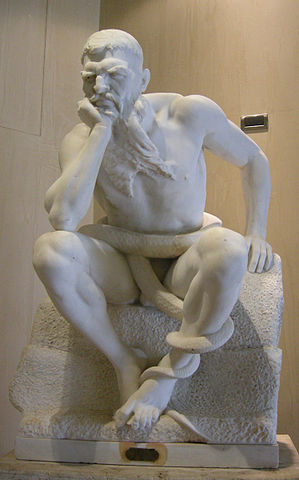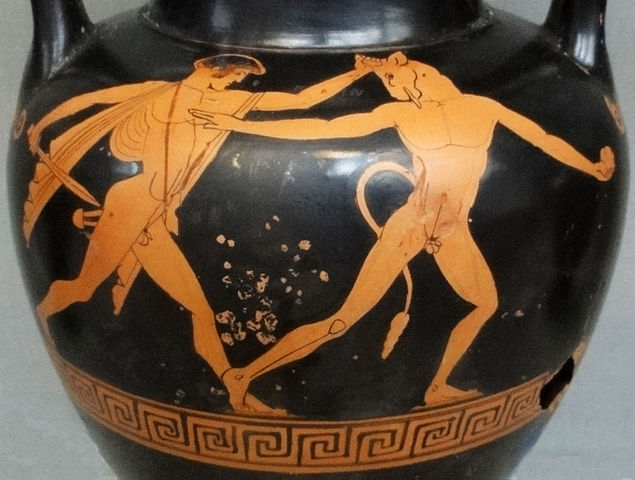King Minos

In greek mythology is king Minos (Greek Μίνως) a son of Zeus and of Europe, the daughter of the phoenician king Agenor and Telephassa.
Zeus transformed into a bull because of his suspicious wife Hera and took Europe on his back and swam with her to Matala on Crete, where he changed back.
The connection between King Minos and minoan civilization is however not assured, since Homer designates him not only as the son of Zeus, but also as Achaean, who are usually equated with the mycenaean greeks.
After his death ruled King Minos with a golden scepter in the underworld at the side of his brother Rhadamanthys and his half-brother Aiakos.
Pasiphae

His wife Pasiphae (pasifaɛː: 'who radiates for all') was the daughter of the solar god Helios and of the titanian daughter and oldest Okeanide Perse.
Pasiphae had 8 children from Minos: Akakallis, Androgeos, Ariadne, Deukalion, Glaukos, Katreus, Phaidra und Xenodike.
In order to ensure his marital fidelity, Pasiphaë applicated a magic on Minos so that in a hug serpents, scorpions and centipedes streamed out of his body. Then Prokris arrived at the island and healed Minos from his suffering. Minos gave her for that an infallible spear and the fast and immortal dog Lailap. Both had his father Zeus once given to Europe.
Pasiphae was especially aware of the fact, that Poseidon had let her fall in love with the cretian bull as a punishment for the fact, that her husband Minos had not sacrificed the bull created by Poseidon for the confirmation of his dominion because of the splendid form of the bull, but had used it to improve his herd. (Apollodorus, Bibliotheke 3.1.4)
In order to unite with the bull, Pasiphae ordered Daidalos to create a hollow wooden cow, into which she could creep. From this union with the bull the Minotauros was born.

King Minos forced King Aegeus every nine years to send seven boys and seven young girls to the labyrinth of Daedalus, which the Minotaur then swallowed. Later Theseus killed the Minotaur.
Allegory
The meaning of the name Minos is controversial. Rudolf Steiner derived it from the Indo-European word root manu (man, Skt. manushya), which may however also be related to men (think, superior, admonish). It thus denotes the reason- and rational gifted thinking man.
In indian Samkhya, 'Manas' is the word for the mind, and thus the opposite pole of the Buddhi. Pasiphae could then be equivalent of the Prakriti.
Similar snake - kings are found in Hinduism among the Daityas, who are also connected with the underworld.
Literature
- Karl Kerényi: Die Mythologie der Griechen, dtv 1345, München 1973 Band I; S. 89,171; ISBN 3-423-01345-1.
- Johannes Hugo Helbig: Minos. In: Wilhelm Heinrich Roscher (Hrsg.): Ausführliches Lexikon der griechischen und römischen Mythologie. Band 2,2, Leipzig 1897, S. 2993–3004 .
- The mythology of ancient Greece and Italy, by Thomas Keightley, 1789-1872 , Published 1838
Weblinks
- Wiki über Pasiphae
- theoi : Rhadamanthys, Minos and Aeacus - the judges of the dead
of Spirituality
universal-path.org